It's a crucial step to measure flow rates, particularly when working in large industrial plants as it can tell the loss or the profit of a business. To measure flow rate, either by mass or volume, a device called a flow meter is used. It works by measuring the amount of liquid that passes through pipes.

Flow meter is a device by measuring the amount of fluids passing through the pipes
What is a Flow Meter's Function?
Flow meters are used in several kinds of applications to measure mass or volume flow rates. The specific use of the meter determines the capacity and style of it. Liquid and gas fluids are both measured by mass or volume flow rates since both of them are related to the density of a material. In the equation m=Q x p, Q is the volume flow rate while mass is m.
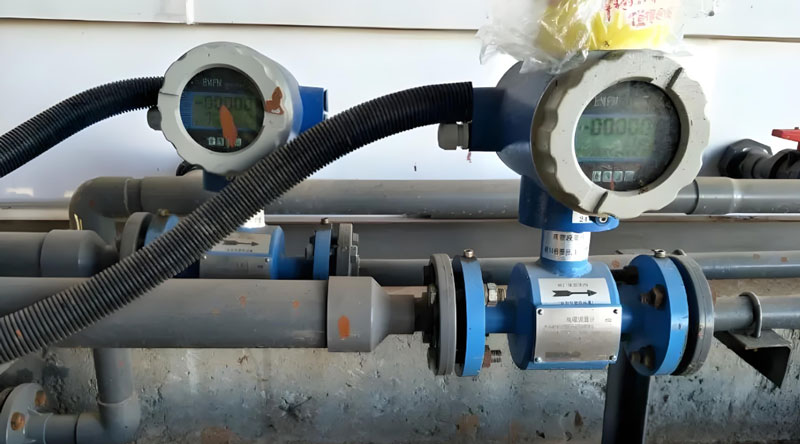
Volume or mass flow measurement by flow meter
The Five Different Kinds of Flow Meters
There are several kinds of flow meters, depending upon the use and the design, materials, and fluid type of the meter. However, there are five main types of flow meters, which include:
1) Differential Pressure Flow Meters
These meters measure the differential pressure when the liquid's flow is related directly to the square root of the produced differential pressure. These have both primary and secondary components as well. The primary component creates a change in the overall kinetic energy by using a pilot tube, an orifice plate, a
balanced flow meter, a flow nozzle, or several venturi flow meters. Then, the secondary component takes measure of the differential pressure to give the signal. These kinds of pressure meters are about twenty percent of overall flow meters, most common in the gas/oil industries. Other industries that use differential pressure flow meters are beverage, pharmaceuticals, paper, mining, HVAC, and chemical application companies.
2) Positive Displacement (PD) Flow Meters
PD meters measure the volume in an area filled with liquid, push the liquid ahead, then fill it again. This calculates the amount of liquid that was transferred. Instead of other meters that measure another element and then convert the numbers into the flow rate, these meters measure the actual flow of the fluid in the meter. Here, the output is directly related to the liquid's volume that comes through the flow meter. PD meter types include
oval-gear flow meters, rotary vane type meters, piston meters, nutating disk meters, and others. These are the most accurate types of flow meters, most often used in transferring fluids and oils such as hydraulics or gasoline. They are also used in-home for gas or water applications.
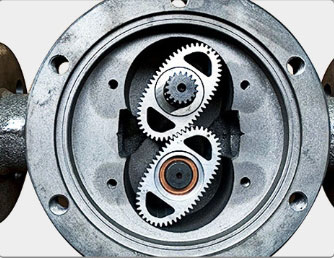
Positive displacement flow meter
Advantages of using positive displacement flow meter
✅ High precision flow meter, PD flow meters directly measure the fixed volume of fluid through mechanical means, so the accuracy is very high, accuracy can reach to 0.2% ~0.5%
✅ Not sensitive to viscosity changes: Unlike
turbine flow meters or vortex flow meters, the accuracy of volumetric flow meters is relatively less affected by changes in fluid viscosity. It is particularly suitable for measuring high viscosity fluids such as heavy oil, lubricating oil, syrup, resin,
asphalt, polymer melt, etc. In these applications, the accuracy of other types of flow meters will significantly decrease.
✅ It is very popular in situations where high-precision measurement is required for trade handover (such as oil, liquefied gas, chemical raw materials).
✅ Excellent
low flow measurement performance:
Due to the fact that the measurement principle is based on the actual displacement of the fluid, positive displacement flow meters can maintain high accuracy even at very low flow rates. They have low sensitivity to fluid flow velocity. Very suitable for measuring small flow or intermittent flow.
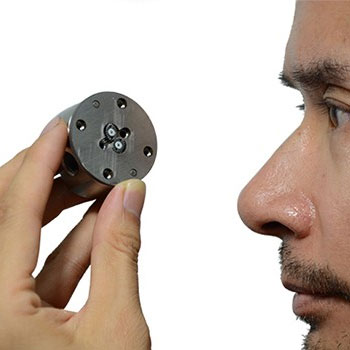
Small flow measurement flow meter
✅ Low requirements for straight pipe sections:
Its measurement principle is less affected by the distribution of fluid velocity, so it usually does not require long upstream and downstream straight pipe sections like turbine flow meters or magnetic flow meters to stabilize the flow field. This makes them more advantageous in situations where installation space is limited.
Limitations of positive displacement flow meter
× Pressure loss: Due to the need for fluid to push internal moving parts (gears, rotors, pistons, etc.), a certain amount of pressure loss will be generated, usually higher than that of electromagnetic flow meters or
ultrasonic flow meters.
× Requirements for cleanliness: For types with precise clearances such as elliptical gears and rotating pistons, solid particles or impurities in the fluid may cause increased wear, jamming, or decreased accuracy. A filter needs to be installed.
× Maintenance requirements: There are moving parts inside that may experience wear and tear after long-term operation, requiring regular maintenance, calibration, and possible component replacement (such as bearings and shaft seals).
× Vibration and pulsation: Mechanical moving parts may produce vibration or noise, and fluid pulsation may also affect their performance and lifespan.
× Not suitable for large pipe diameters and large flow rates: Due to the size and strength of the mechanical structure, it is usually not suitable for very large pipe diameters and flow rates; the max size for positive displacement is around 10 inches.
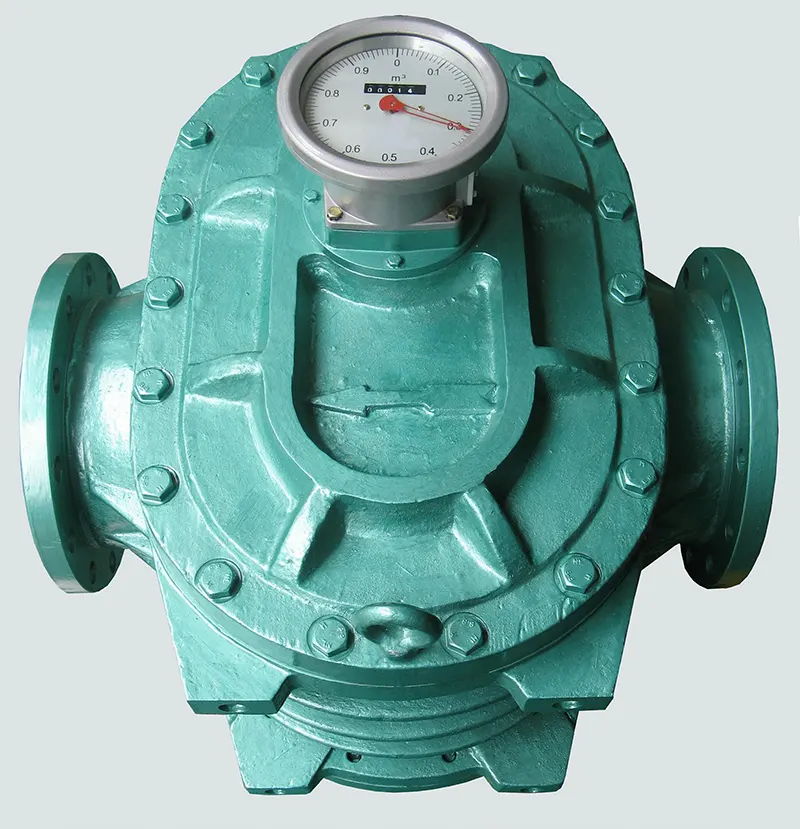
10 inches positive displacement flow meter
3) Velocity Flow Meters
These flow meters measure the velocity of a stream of liquid to determine the volumetric flow rate. They are less sensitive if and when the Reynold's number of a certain liquid is greater than 10,000. These kinds of flow meters include paddlewheel, turbine flowmeter, vortex shredding flowmeter, sonic/ultrasonic, and electromagnetic flow meters.
Velocity type flow meter- Turbine flow meter
The turbine flowmeter uses fluid to drive the turbine to rotate, and its speed is proportional to the flow rate. The rotating blade cuts the magnetic induction coil to generate a pulse signal, which is converted to obtain the flow rate.
Advantage:
✅ High precision (± 0.5%), wide range ratio (10:1)
✅ Fast response (millisecond level), suitable for pulsating flow
✅ Compact structure with minimal pressure loss
✅ Low price cost flow meter
Disadvantages:
×Bearings are prone to wear and tear (requiring regular maintenance)
×High requirements for cleanliness of the medium (solid particles may jam the blades)
×Greatly affected by viscosity (decreased accuracy of high viscosity fluids)
Typical applications:
Petroleum/Chemical Industry: Measurement of Finished Oil and Liquefied Gas Trade, diesel, kerosene
Water treatment: monitoring of high flow tap water, clean water, drinking water
Energy: metering at natural gas pressure regulating stations
Medicine: Control of Clean Fluid Filling.solvent
Applicable scenarios: clean, low viscosity (<10cP), stable flow medium; Prohibited for fluids containing impurities and corrosive substances
Velocity type flow meter-magnetic flow meter
Principle of
electromagnetic flowmeter: Based on Faraday's law of electromagnetic induction, the conductive fluid cuts the magnetic induction line to generate induced electromotive force (E=BDv), the electromotive force is proportional to the flow rate, and the flow rate is calculated by electrode detection.
Advantage:
✅ Unobstructed flow component: zero pressure loss, suitable for corrosive/particle containing fluids,such as HCL, H2SO3, NaOH solution, slurry, waste water
✅ High precision (± 0.5%), wide range ratio (20:1)
✅ Bidirectional measurement, high pressure resistance (up to 40MPa)
Disadvantages:
X Only measure conductive liquids (conductivity>5 μ S/cm), cannot measure oil, organic liquid.
X Bubbles affect accuracy
X Cannot measure gas flow and steam flow
Typical applications:
Water treatment: sewage/raw water metering
Chemical industry: acid/alkali/slurry transportation monitoring
Food: Beverage/Milk Pipeline
Metallurgy: slurry flow control
Velocity type flow meter-
Vortex flow meter
Principle of
vortex flowmeter: When a fluid flows through a resistive fluid (vortex generator), regular vortices (Karman vortex street) are alternately generated on both sides. The vortex frequency is proportional to the flow velocity, and the flow rate is calculated by detecting the frequency through a sensor.
Advantages
✅ No moving parts: Wear resistant, low maintenance cost
✅ Widely applicable media: gas/liquid/vapor can be measured
✅ Wide range ratio (10:1), high temperature resistance (less than 450°C)
Disadvantages
X Low flow velocity with poor accuracy (needs to be>0.5m/s)
X Vibration sensitivity (requires installation of vibration reduction brackets)
X High requirements for straight pipe section (first 20D and then 5D)
Typical application
Steam metering: Boiler steam/industrial pipeline network (saturated/superheated steam)
Energy: Natural Gas/Compressed Air Trade Settlement
Chemical industry: solvent/liquefied gas flow monitoring
Heating: Measurement of hot water circulation system
4) Mass Flow Meters
These meters are best used in processes related to mass since they measure the force that is created from mass' acceleration. In detail, the force is noted as the mass' movement over a unit of time passing, rather than the volume over a unit of time. Mass flow meter subtypes include
thermal dispersion flow meter and Coriolis mass flow meters. The most common uses for these meters are ones related to chemical and gas industries. Other areas of use are power, mining, pharmaceuticals, and wastewater.
Thermal mass flow meter
Principle of
Thermal Gas Flow Meter: Based on the principle of thermal diffusion, the temperature difference between the heating sensor and the temperature sensor varies with the gas flow rate, and the flow rate is calculated by measuring the temperature difference or heating power change.
Advantage:
✅ No moving parts: maintenance free, vibration resistant
✅ Ultra low flow velocity sensitivity (measured from 0.05m/s)
✅ Range ratio is extremely wide (100:1), with low requirements for straight pipe sections
Disadvantages:
X Only applicable to gases (liquid/vapor is invalid)
X Gas measurement result is affected by gas composition
X High dust/oil mist conditions can easily contaminate the probe
Typical applications:
Environmental Protection: Monitoring of Flue Gas/Exhaust Gas Emissions (CEMS System)
Energy: Compressed air/natural gas flow measurement
Semiconductor: High purity specialty gas metering (Ar/N ₂)
HVAC: Flow control of air supply ducts
Coriolis flowmeter
Principle of
Coriolis mass flowmeter: When fluid flows through a vibrating measuring tube, Coriolis force is generated, causing a phase shift in the tube wall. The offset is proportional to the fluid mass flow rate, and the flow rate is calculated by detecting the phase difference through a sensor (synchronously measuring the density).
advantage:
✅ Directly measuring mass flow rate (non volume conversion) with extremely high accuracy (± 0.1%)
✅ Multi parameter measurement: synchronous measurement of mass flow, density, temperature, volume flow rate
✅ Widely applicable media: liquids/gases/slurries/high viscosity fluids
Disadvantages:
X Extremely high cost (3-5 times more expensive than other flow meters)
X High pressure loss (due to complex structure resulting in high flow resistance)
X Restricted large pipe diameter ,max size is DN250
Typical applications:
Petrochemical industry: crude oil trade handover, precise measurement of additives
Food and medicine: syrup/molasses/lotion ratio filling
Energy: LNG quality flow monitoring
Research: Multiphase Flow Experimental Analysis
5) Open Channel Flow Meters
Open channel meters measure liquids within open channels like weirs, flumes, or v-notches. These are overflows, which are dam structures, which let a small or especially concentrated liquid free-flow dependent upon the structure's size and shape. Open channel flow meters allow flow rate readings to be measured. The most common uses of these flow meters are within free-flowing liquid settings, like rivers, streams, sewers/wastewater systems, or irrigation waterways.
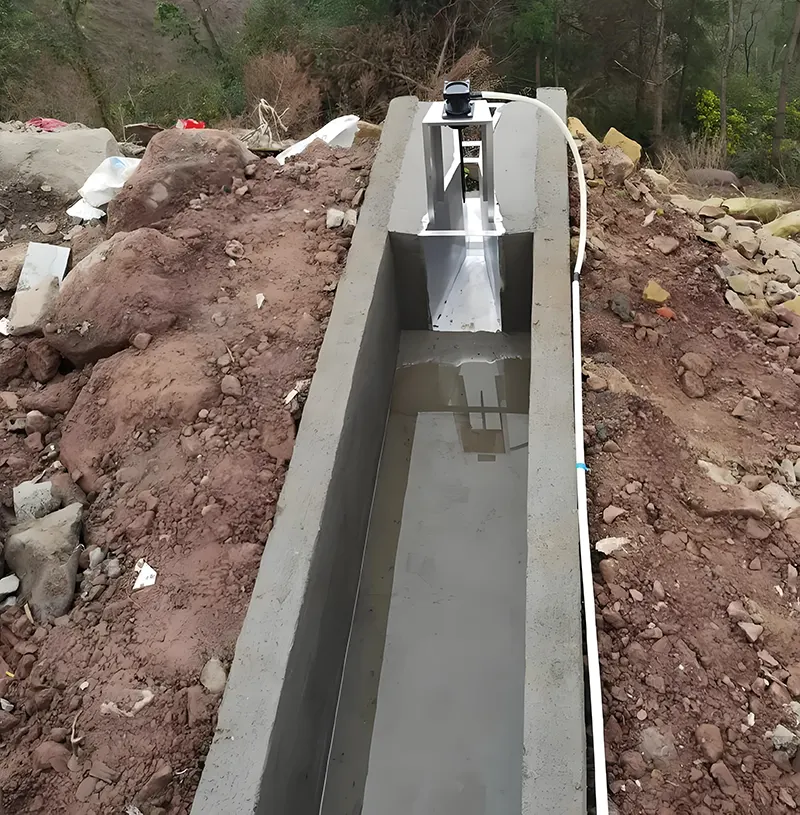
Open channel flow meter for irrigation water ways
Related Products:






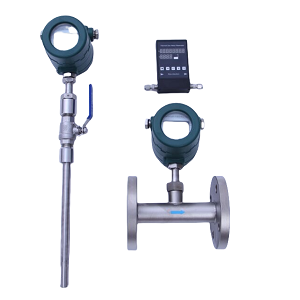 Thermal Mass Flow Meter2017/05/27Low cost gas flow meter.
Thermal Mass Flow Meter2017/05/27Low cost gas flow meter. Coriolis Mass Flow Meter2017/04/12Direct mass flow measurement.
Coriolis Mass Flow Meter2017/04/12Direct mass flow measurement. SLW-N Liquid Turbine flow sensor2019/06/01Low cost turbine flow sensor.
SLW-N Liquid Turbine flow sensor2019/06/01Low cost turbine flow sensor. Oval gear flow meter2019/07/09Positive displacement flow meter
Oval gear flow meter2019/07/09Positive displacement flow meter Vortex Flow Meter2017/04/12Vortex Flow meter is for clean liquid, gas and steam flow measurement. Contact us to choose proper type flow sensor and get the competitive quotation.VIEW
Vortex Flow Meter2017/04/12Vortex Flow meter is for clean liquid, gas and steam flow measurement. Contact us to choose proper type flow sensor and get the competitive quotation.VIEW Coriolis mass flow meter2019/06/12Best accuracy flow meter
Coriolis mass flow meter2019/06/12Best accuracy flow meter